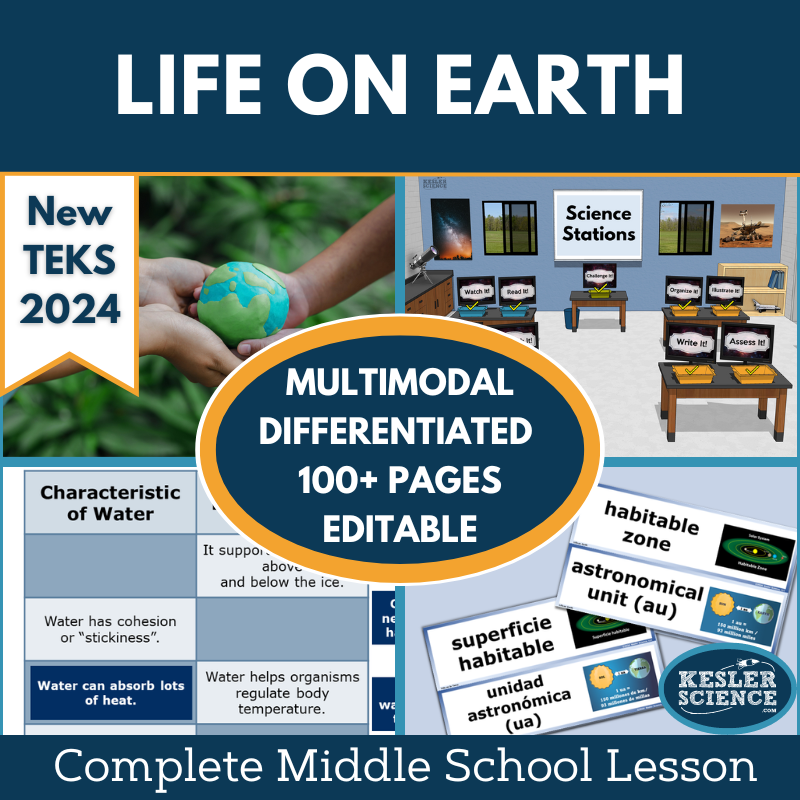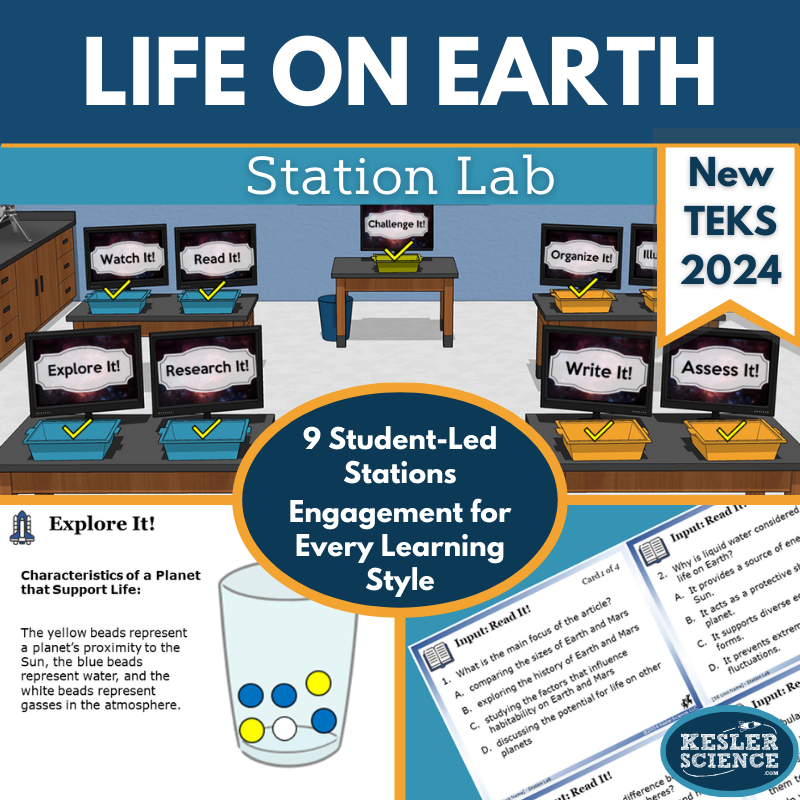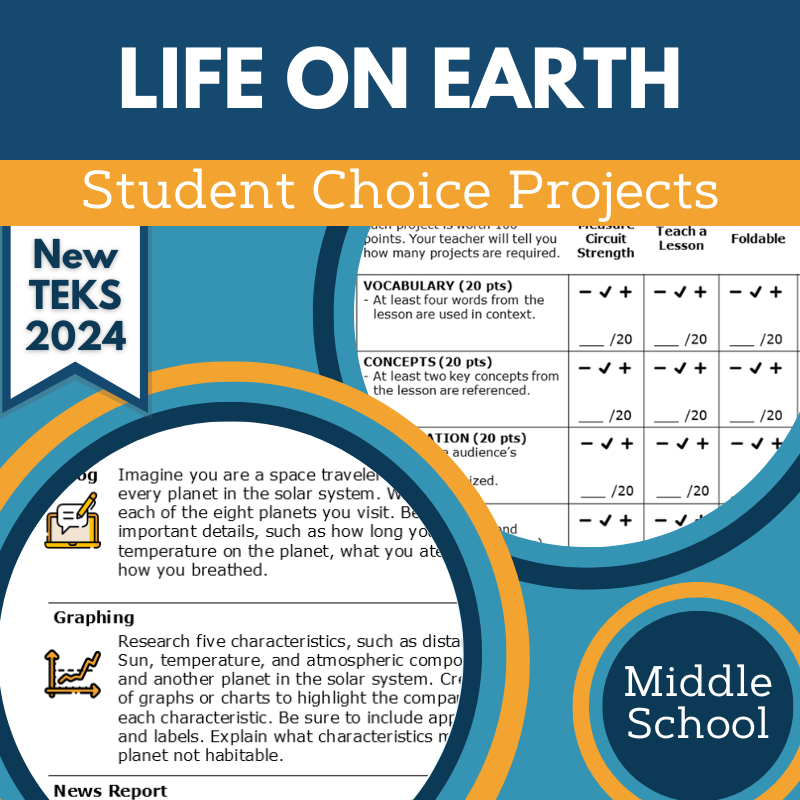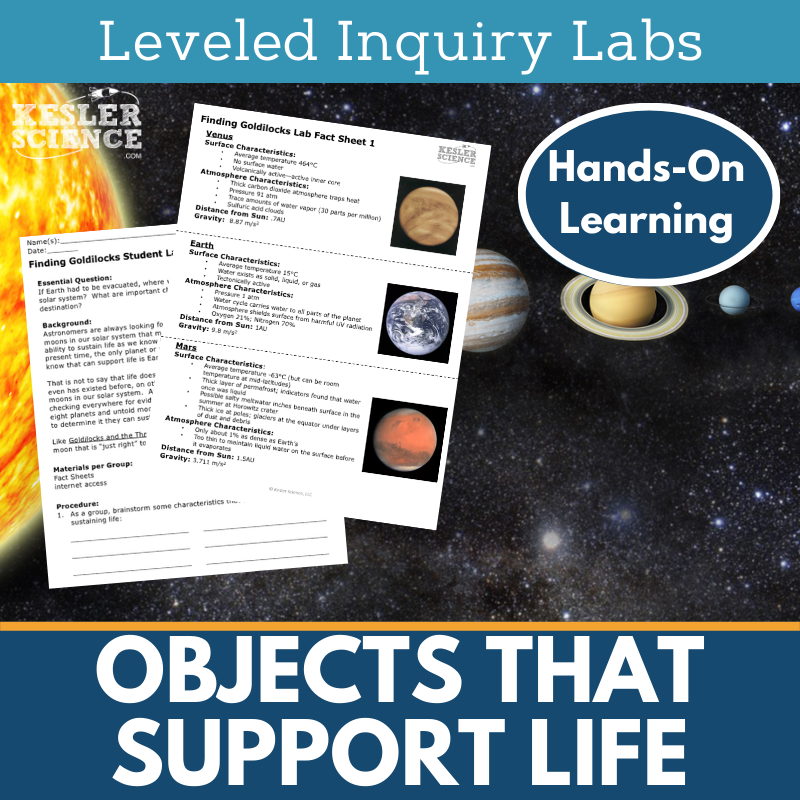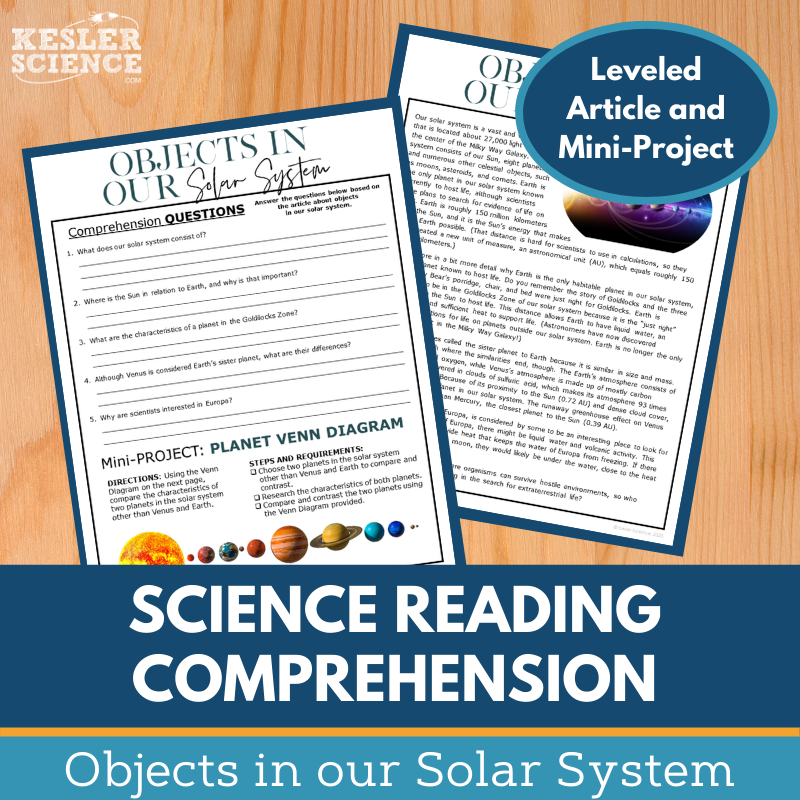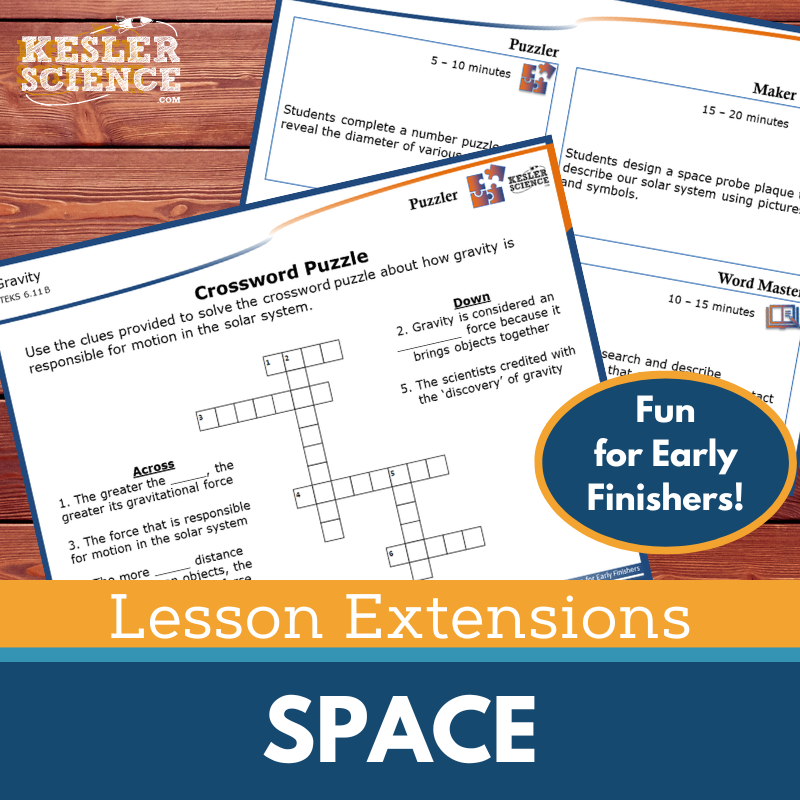Life on Earth Activities for Middle School Science
Explore how Earth's proximity to the Sun, water presence, and atmospheric composition support life with this engaging 5E lesson aligned to TEKS 7.9C. The resources below will give students a comprehensive understanding of conditions that support life on Earth. All of the following materials are also included in the Kesler Science Membership.
The Kesler Science 5E Lesson on Earth’s characteristics for life explores how the Sun’s proximity, water presence, and atmospheric composition support life. This engaging, student-led unit includes presentations, worksheets, choice projects, and assessments, all fully editable for flexibility in digital or print formats. The lesson aligns with TEKS 7.9C and offers Spanish translations for key materials.
Following the 5E Model, the unit begins with engaging discussions and activities. Exploration features a differentiated, multimodal station lab with nine interactive stations, including hands-on experiments, reading passages, research tasks, and creative outputs like drawing and categorization. Explanation includes editable PowerPoints, interactive notebook templates, and note-taking guides. Elaboration allows students to extend learning through choice projects, while Evaluation provides STAAR 2.0-aligned assessments, worksheets, and review questions.
Designed for middle school students, this low-prep unit ensures active participation and comprehension through multimodal learning. It is suitable for both in-class and virtual instruction, making science engaging and accessible for all learners.
The Kesler Science 5E Lesson on Earth’s characteristics for life explores how the Sun’s proximity, water presence, and atmospheric composition support life. This engaging, student-led unit includes presentations, worksheets, choice projects, and assessments, all fully editable for flexibility in digital or print formats. The lesson aligns with TEKS 7.9C and offers Spanish translations for key materials.
Following the 5E Model, the unit begins with engaging discussions and activities. Exploration features a differentiated, multimodal station lab with nine interactive stations, including hands-on experiments, reading passages, research tasks, and creative outputs like drawing and categorization. Explanation includes editable PowerPoints, interactive notebook templates, and note-taking guides. Elaboration allows students to extend learning through choice projects, while Evaluation provides STAAR 2.0-aligned assessments, worksheets, and review questions.
Designed for middle school students, this low-prep unit ensures active participation and comprehension through multimodal learning. It is suitable for both in-class and virtual instruction, making science engaging and accessible for all learners.
Engage your middle school students with this student-led station lab aligned to TEKS 7.9C, exploring the characteristics that make Earth habitable, such as its distance from the Sun, presence of water, and atmospheric composition. Designed for in-class or virtual learning, this modular lesson promotes independent learning with nine differentiated stations featuring videos, readings, research, and hands-on activities.
Students interact with new concepts through activities like experiments, video analysis, reading comprehension, and research. They demonstrate understanding by organizing information, illustrating models, writing responses, and completing assessments. A challenge station provides extension activities for advanced learners. This low-prep, high-engagement resource fosters critical thinking and active learning.
Engage your middle school students with this student-led station lab aligned to TEKS 7.9C, exploring the characteristics that make Earth habitable, such as its distance from the Sun, presence of water, and atmospheric composition. Designed for in-class or virtual learning, this modular lesson promotes independent learning with nine differentiated stations featuring videos, readings, research, and hands-on activities.
Students interact with new concepts through activities like experiments, video analysis, reading comprehension, and research. They demonstrate understanding by organizing information, illustrating models, writing responses, and completing assessments. A challenge station provides extension activities for advanced learners. This low-prep, high-engagement resource fosters critical thinking and active learning.
The Life on Earth Student Choice Projects align with the 2021 TEKS standard 7.9C, giving middle school students the opportunity to select a project that matches their preferred output style. A project page outlines six student-led options plus a “design your own” project, with an editable rubric for teacher, peer, or self-assessment. This resource is also included in the Life on Earth Complete Lesson for TEKS 7.9C.
These flexible, multimodal projects allow students to creatively demonstrate their understanding. Two versions of the project page support differentiation, with modified options for students needing remediation and challenge opportunities for advanced learners. Teachers can adjust the rubric to fit their grading needs.
The projects require standard classroom supplies such as paper, markers, and scissors, with many options available for digital completion.
The Life on Earth Student Choice Projects align with the 2021 TEKS standard 7.9C, giving middle school students the opportunity to select a project that matches their preferred output style. A project page outlines six student-led options plus a “design your own” project, with an editable rubric for teacher, peer, or self-assessment. This resource is also included in the Life on Earth Complete Lesson for TEKS 7.9C.
These flexible, multimodal projects allow students to creatively demonstrate their understanding. Two versions of the project page support differentiation, with modified options for students needing remediation and challenge opportunities for advanced learners. Teachers can adjust the rubric to fit their grading needs.
The projects require standard classroom supplies such as paper, markers, and scissors, with many options available for digital completion.
The Objects that Support Life Inquiry Lab aligns with TEKS guiding students to analyze the characteristics that make planets and moons suitable for life. Using Fact Sheets and optional internet research, students will rank celestial bodies as potential locations for future human habitation, drawing inspiration from the concept of finding a planet that is "just right."
This resource includes three differentiated lab versions to support all learners. The Dependent Student Lab offers guided procedures with inquiry questions for on-level learners. The Modified Student Lab provides a structured experience with sentence stems and multiple-choice questions, ideal for students needing modifications. The Independent Student Lab is student-driven, allowing advanced learners to make their own decisions throughout the process.
Teacher resource pages include prep time details, standards, objectives, materials, and directions. Answer keys and CER-based reflection questions support student reasoning. All pages are editable for customization. Materials needed per group include Fact Sheets 1, 2, and 3 (which can be cut into cards) and optional internet access for research.
The Objects that Support Life Inquiry Lab aligns with TEKS guiding students to analyze the characteristics that make planets and moons suitable for life. Using Fact Sheets and optional internet research, students will rank celestial bodies as potential locations for future human habitation, drawing inspiration from the concept of finding a planet that is "just right."
This resource includes three differentiated lab versions to support all learners. The Dependent Student Lab offers guided procedures with inquiry questions for on-level learners. The Modified Student Lab provides a structured experience with sentence stems and multiple-choice questions, ideal for students needing modifications. The Independent Student Lab is student-driven, allowing advanced learners to make their own decisions throughout the process.
Teacher resource pages include prep time details, standards, objectives, materials, and directions. Answer keys and CER-based reflection questions support student reasoning. All pages are editable for customization. Materials needed per group include Fact Sheets 1, 2, and 3 (which can be cut into cards) and optional internet access for research.
This Objects in our Solar System Science Reading Comprehension Lesson helps students explore the characteristics of celestial objects that support life. Through a nonfiction article, comprehension questions, and a compare-and-contrast activity, students analyze planets in our solar system while developing science literacy.
Designed for grades 6-8 (with higher-level 5th graders in mind), the resource includes two leveled articles (Lexile 1100-1300), five to seven comprehension questions, and a hands-on mini-project. A Cornell notes template is provided for structured note-taking. Engaging graphics enhance the lesson and can be printed in grayscale.
Ideal for in-person or virtual learning, the resource is compatible with Google Classroom, MS Teams, Schoology, and Canvas, allowing students to complete assignments digitally. It serves as an excellent tool for sub plans, extra credit, ISS, or whole-class instruction, fostering critical thinking, classroom discussions, and textual analysis.
This Objects in our Solar System Science Reading Comprehension Lesson helps students explore the characteristics of celestial objects that support life. Through a nonfiction article, comprehension questions, and a compare-and-contrast activity, students analyze planets in our solar system while developing science literacy.
Designed for grades 6-8 (with higher-level 5th graders in mind), the resource includes two leveled articles (Lexile 1100-1300), five to seven comprehension questions, and a hands-on mini-project. A Cornell notes template is provided for structured note-taking. Engaging graphics enhance the lesson and can be printed in grayscale.
Ideal for in-person or virtual learning, the resource is compatible with Google Classroom, MS Teams, Schoology, and Canvas, allowing students to complete assignments digitally. It serves as an excellent tool for sub plans, extra credit, ISS, or whole-class instruction, fostering critical thinking, classroom discussions, and textual analysis.
The Earth & Venus Science Writing Prompt Activity engages middle school students in a compare-and-contrast writing exercise to reinforce their understanding of Earth science. Aligned with TEKS, this activity explores the characteristics of objects in our solar system that support life, such as proximity to the Sun, the presence of water, and atmospheric composition. Designed for both in-person and virtual learning, it fosters science reasoning and writing skills in an engaging way.
This resource includes teacher directions with an answer guide and rubrics, projection and print handouts, and a digital PowerPoint version for Google Slides. It works well as a cross-curricular activity, pre-test assessment, student choice project, or as enrichment for early finishers. Ideal for extra credit, make-up work, differentiation, or TELPAS samples, this writing prompt enhances student engagement and comprehension while providing a creative outlet for learning.
The Earth & Venus Science Writing Prompt Activity engages middle school students in a compare-and-contrast writing exercise to reinforce their understanding of Earth science. Aligned with TEKS, this activity explores the characteristics of objects in our solar system that support life, such as proximity to the Sun, the presence of water, and atmospheric composition. Designed for both in-person and virtual learning, it fosters science reasoning and writing skills in an engaging way.
This resource includes teacher directions with an answer guide and rubrics, projection and print handouts, and a digital PowerPoint version for Google Slides. It works well as a cross-curricular activity, pre-test assessment, student choice project, or as enrichment for early finishers. Ideal for extra credit, make-up work, differentiation, or TELPAS samples, this writing prompt enhances student engagement and comprehension while providing a creative outlet for learning.
The WIKI Tickets© Space Set provides engaging and flexible formative assessments for 6th-8th grade science. This set includes 14 topics, each available in five formats: a full-screen projection version, three printable handout sizes, and a digital interactive version compatible with PowerPoint and Google Slides.
Aligned with NGSS and TEKS standards, these assessments cover key space science topics such as the lunar cycle, electromagnetic spectrum, solar system gravity, and space exploration. Each set includes a table of contents file for standard alignment reference. Designed for both in-person and virtual learning, WIKI Tickets© can be used as exit tickets, bellringers, or quick checks for student understanding. They can be projected for whole-class participation, printed for individual work, or assigned digitally for 1:1 or remote learning.
The WIKI Tickets© Space Set provides engaging and flexible formative assessments for 6th-8th grade science. This set includes 14 topics, each available in five formats: a full-screen projection version, three printable handout sizes, and a digital interactive version compatible with PowerPoint and Google Slides.
Aligned with NGSS and TEKS standards, these assessments cover key space science topics such as the lunar cycle, electromagnetic spectrum, solar system gravity, and space exploration. Each set includes a table of contents file for standard alignment reference. Designed for both in-person and virtual learning, WIKI Tickets© can be used as exit tickets, bellringers, or quick checks for student understanding. They can be projected for whole-class participation, printed for individual work, or assigned digitally for 1:1 or remote learning.
Lesson Extensions provide engaging, student-choice activities designed to challenge early finishers and deepen their understanding of space science standards. These activities help fill downtime, reinforce critical thinking, and keep students engaged with rigorous yet enjoyable learning opportunities. Covering topics such as the lunar cycle, space travel, gravity, and the origin of the universe, they provide flexible, high-level resources that support independent learning and enrichment.
Each extension includes four interactive components: Puzzler for problem-solving, Maker Space for hands-on STEAM activities, Tech Connection for digital demonstrations, and Word Master for creative writing. With teacher directions, answer keys, and both print and projection versions, these extensions are perfect for lesson wrap-ups, enrichment, or independent challenges, ensuring that students remain engaged and learning at a deeper level. Aligned with NGSS and TEKS science standards, these activities encourage deeper exploration of space science concepts.
Lesson Extensions provide engaging, student-choice activities designed to challenge early finishers and deepen their understanding of space science standards. These activities help fill downtime, reinforce critical thinking, and keep students engaged with rigorous yet enjoyable learning opportunities. Covering topics such as the lunar cycle, space travel, gravity, and the origin of the universe, they provide flexible, high-level resources that support independent learning and enrichment.
Each extension includes four interactive components: Puzzler for problem-solving, Maker Space for hands-on STEAM activities, Tech Connection for digital demonstrations, and Word Master for creative writing. With teacher directions, answer keys, and both print and projection versions, these extensions are perfect for lesson wrap-ups, enrichment, or independent challenges, ensuring that students remain engaged and learning at a deeper level. Aligned with NGSS and TEKS science standards, these activities encourage deeper exploration of space science concepts.
This Amazing Anchors Phenomenon Lesson engages students in learning about Earth’s habitable characteristics through a real-world connection to Europa, one of Jupiter’s moons. The lesson includes an introductory reading with comprehension and extension questions to build background knowledge, followed by an explanatory reading that breaks down the science behind Earth's ability to support life, with reinforcement questions to extend learning.
Aligned with TEKS, this no-prep resource includes teacher directions, answer keys, projection slides, and both print and digital formats for Google Classroom and other LMS platforms. A differentiated version provides sentence starters for student support. Designed to bookend a lesson, these engaging readings serve as supplements to reinforce learning in any in-person or virtual classroom.
This Amazing Anchors Phenomenon Lesson engages students in learning about Earth’s habitable characteristics through a real-world connection to Europa, one of Jupiter’s moons. The lesson includes an introductory reading with comprehension and extension questions to build background knowledge, followed by an explanatory reading that breaks down the science behind Earth's ability to support life, with reinforcement questions to extend learning.
Aligned with TEKS, this no-prep resource includes teacher directions, answer keys, projection slides, and both print and digital formats for Google Classroom and other LMS platforms. A differentiated version provides sentence starters for student support. Designed to bookend a lesson, these engaging readings serve as supplements to reinforce learning in any in-person or virtual classroom.
Year-Round Resources
These year-round activities will increase your students' understanding of many middle school science topics. All of these activities are also included in the Kesler Science Membership.
Visual Data & Graphing
You're not alone if your students struggle with understanding graphs, charts, and tables. It's a skill that takes an enormous amount of practice. This resource will help students build a strong foundation in analyzing data and creating their own data visualizations.
Bell Ringers and Warm-Ups
These middle school science bell ringers are an excellent way to engage your students as soon as they walk into your classroom. This comprehensive FULL YEAR resource includes everything you need to start off each science class with an interesting warm-up activity.
Review Board Games
Each game board has been carefully designed to keep students engaged. There are 10 different action spaces on each board and dozens of question cards. All of the actions are related to science concepts and keep the students motivated throughout the game.
Each game is ready to play. Simply print out the board and the cards and let the students enjoy reviewing nine different units.
Essential Questions and Standards
Below are the essential questions and standards associated with the lessons and activities included in the atoms unit. This topic is only one of more than 100 middle school science topics included in the Kesler Science Membership.
-
What characteristics of Earth support living things?
-
How does Earth’s proximity to the Sun, the presence of water, and the atmosphere’s composition allow life to exist?
-
TEKS Science - 7.9C Life on Earth
Kesler Science Membership
Imagine never having to search for another middle school science lesson again. The membership gives you access to ALL of the Kesler Science products in one place (Yes, including everything above).
Say goodbye to long hours of lesson prep.

